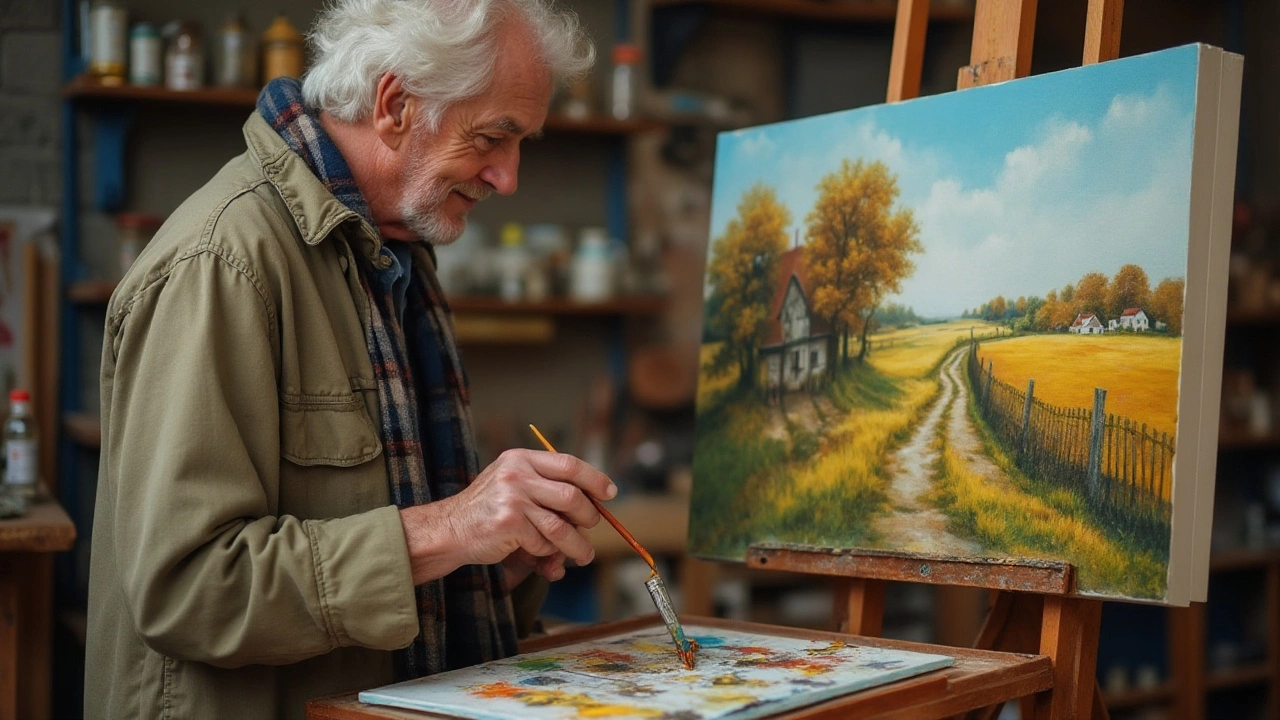In the vivid world of oil painting, linseed oil holds an esteemed place among artists' materials. Known for its versatility and natural origins, this oil can dramatically change how an oil paint behaves. From the way it spreads across the canvas to how quickly it dries, linseed oil is much more than just a medium enhancer.
Artists have long treasured its ability to deepen the pigment's brilliance, making colors appear more vibrant and appealing. The slow yet steadfast drying process facilitated by linseed oil allows for exquisite detail and texture that only oil painting provides.
Beyond the technical advantages, linseed oil offers a link to centuries of artistic tradition. Understanding its role in oil painting not only enhances one’s skills but also connects modern artists with the historical roots of this art form. Explore how to use linseed oil effectively and see your artistic expression flourish.
- Understanding Linseed Oil
- Benefits of Adding Linseed Oil
- Techniques for Using Linseed Oil
- Historical Significance
- Practical Tips for Artists
Understanding Linseed Oil
Linseed oil, a familiar term to anyone who has dabbled with oil painting techniques, holds more significance than just being an auxiliary component of paint. Derived from the seeds of the flax plant, linseed oil's emergence as an artistic medium dates back to the Renaissance, when painters like Jan van Eyck pioneered the use of oil-based mediums. This natural oil is rich in fatty acids which contribute to its ability to enhance the texture and gloss of oil paints. It allows the pigment to blend seamlessly, enabling a smooth application over the canvas.
One striking feature of linseed oil is its impact on the drying time of oil paints. Unlike some quick-drying mediums that may limit the artist's ability to rework a piece, linseed oil dries slowly, allowing for detailed layering and subtle blending. This gradual process enables artists to achieve depth and detail that are hallmarks of oil paintings. Moreover, linseed oil does not merely sit on the surface; it interacts deeply with the pigments, often enhancing the vibrancy of the colors used, thus bringing an internal glow to the artwork that can last for centuries.
The Chemistry Behind Linseed Oil
The science behind linseed oil's effectiveness lies in its chemical composition. It contains a high level of alpha-linolenic acid, a type of omega-3 fatty acid that facilitates the oxidative drying process. When linseed oil mixes with oil paints, it undergoes a chemical reaction with oxygen in the air, causing it to polymerize and form a strong, flexible film. This durability ensures that artworks retain their integrity over time, even in varying environmental conditions. The polymerization process, while advantageous, must be managed carefully, as excessive exposure to oxygen can lead to yellowing over decades.
"Linseed oil is more than a binder; it is the soul of the paint," says renowned art restorer and historian, Agnès Goyet. Her words echo the sentiments of many artists who have experienced the transformative potential of linseed oil firsthand.Linseed oil not only enhances the beautiful spread of colors but also heightens the longevity of the art, making it a preferred choice in paint texture manipulation. This reliability is why many artists across the world, from budding painters to seasoned professionals, regard linseed oil as an indispensable resource.
Benefits of Adding Linseed Oil
In the realm of oil painting, the addition of linseed oil is a practice cherished by artists across the spectrum, from budding novices to revered professionals. One of the foremost benefits of incorporating linseed oil into oil paints is its ability to alter the paint's consistency, turning thick pastes into more fluid forms without compromising the intensity of the color. This adjustment facilitates smoother application, making it easier for the paint to glide across the canvas, which is particularly beneficial when aiming for large swathes of color or intricate detail work. By blending paint smoothly, artists can achieve seamless transitions between hues, which are essential for realistic depictions in landscapes, portraits, and still-life compositions.
Furthermore, linseed oil is famed for extending the drying time of oil paints. This slower drying time is a double-edged sword — on one hand, it allows artists ample time to manipulate and perfect their work, providing the chance to step back, evaluate, and make necessary adjustments before the paint sets. For instance, a painter working on a multi-hour session finds great utility in this feature, as it provides the flexibility to work wet-on-wet, a technique preferred for achieving subtle gradations and soft edges. On the other hand, it requires patience, as each layer must be adequately dry before additional layers are applied to avoid undesirable mixing of colors. “Linseed oil is a traditional medium, beloved for its versatility and practical advantages,” says celebrated artist John Sloan, emphasizing its enduring place in the painter's toolkit.
Beyond functional benefits, linseed oil also plays a critical role in enhancing the longevity of artworks. As an organic substance, it naturally binds with the oil paint, creating a durable film upon drying that helps preserve the vibrancy of colors over time. This protective layer guards against the ravages of oxidation, which can dull or crack paintings as they age. In addition, the refractive index of linseed oil closely matches that of typical oil pigments, allowing light to penetrate the paint layer and bounce back, resulting in a luminous and rich appearance. This quality is particularly noticeable in the reds and deep blues of an artist's palette which often need a boost to retain their intended vibrancy on the canvas.
Moreover, linseed oil has been a staple in art history, noted for its ability to bring depth and sheen to oil paintings. Ancient painters, including the old masters like Rembrandt, were known to rely on linseed oil to achieve their signature glow and fine details. Its use allowed them to develop layers of glazes that added a mesmerizing glow to their pieces, imbuing them with a visual depth that captivated viewers. Even in today's fast-paced world, the historical significance of linseed oil is a testament to its continued importance in the art of oil painting, bridging the gap between time-honoured techniques and contemporary creative expressions.

Techniques for Using Linseed Oil
When venturing into the realm of oil painting, mastering the use of linseed oil opens a treasure trove of possibilities for artists. This oil, derived from the seeds of the flax plant, is celebrated for its unique ability to affect both the application and finish of oil-based paints. One of the primary methods of using linseed oil involves mixing it directly with paint to improve its texture and workability. By doing so, artists can transform thick, unyielding paints into smooth, luscious applications that glide gracefully across the canvas. This adjustment can be particularly beneficial when tackling large backgrounds or intricate details, where a seamless application is crucial to the painting's overall harmony.
A noteworthy technique is the varying ratio of linseed oil to paint, depending on the desired effect. Beginners may start with equal parts oil and paint, ensuring a balanced blend that maintains color intensity while enhancing flow. More experienced painters might experiment with different proportions, adding more oil for a glossier finish or less for a matte appearance. This flexibility allows artists to tailor the medium to individual preferences and projects, an advantage not to be underestimated. Using too much oil, however, can lead to delayed drying times and a weakened paint film, necessitating a careful balance with each use. An old master's rule of thumb was "fat over lean," indicating that layers should be progressively more fatty, or oil-rich, as the painting builds from bottom to top. This practice helps avoid cracking over time by ensuring each layer adheres properly to the one beneath it.
Incorporating linseed oil into the painting process also allows for the creation of subtle glazes. These thin, transparent layers of color, applied over dried paint, can add depth and dimension, elevating the overall visual impact. Artists often employ a brush or rag to apply glazes, blending softly to achieve seamless transitions and luminous effects. By juxtaposing various hues through glazing, paintings can acquire a richness that more opaque techniques cannot achieve alone. Experimentation plays a key role here, as the right mix of paint and oil can differ greatly between artists and artworks. Even renowned painter Vincent van Gogh believed in the transformative power of linseed oil and remarked,
"The texture should be crisp, the color vibrant, and nothing delivers that better than the careful use of this oil."
Finally, linseed oil greatly influences the drying time of oil paints. Adjusting the amount of oil in your mix can vary how quickly or slowly the paints set. Longer drying times allow for extensive blending, creating gradients and contrasts that define the final aesthetic. Meanwhile, thinner applications dry faster, useful in layering techniques where subsequent application is necessary without delay. This characteristic has made linseed oil a staple choice among artists seeking control over their work pace and progress. While it can be advantageous, artists must remain attentive, as too much oil can result in overly fragile works susceptible to damage down the line. As you continue to explore the artistic potential of linseed oil, remember that each brushstroke adds to a legacy created by both nature and craftsmanship, enriching the world of oil painting for generations to come.
Historical Significance
The history of art is beautifully intertwined with the evolution of materials, and linseed oil has played a vital role in the journey of oil painting. Its use dates back to as early as the 12th century, finding its way into the palettes of artists across Europe and beyond. Renowned painters such as Jan van Eyck of the Northern Renaissance period used linseed oil to their advantage, mastering the delicate balance it offered in terms of texture and luminosity in their works. The Flemish technique, famously associated with Van Eyck, tapped into the properties of linseed oil to achieve a deep glow and captured intricate details that were revolutionary at the time.
Historically, linseed oil wasn't just favored for its aesthetic contributions. Its natural drying properties were crucial, especially in an era before synthetic dryers were around. This slow-drying feature allowed artists to work on their pieces over extended periods, meticulously blending and layering paints to create rich, dynamic compositions. It's fascinating how this humble oil was pivotal in transitioning artwork from the flat, matte surfaces of tempera paint to the more vivid and textured forms seen in oil paintings. As Leonardo da Vinci once suggested, "Painting is a mental thing," indicating the level of thoughtfulness and technique required in which linseed oil was a silent yet significant contributor.
Moving through the ages, artists like Rembrandt took full advantage of linseed oil to create dramatic contrasts and lifelike textures. His use of glazes and impastos showcased how the oil could build volume, capture light, and give life to shadows, adding realism and depth to portraits. This progression continued in the works of other Baroque masters and then into the Romantic era, where artists like Delacroix employed it for bold and free brushwork, emphasizing expression and emotion. Thus, linseed oil transcended its role as just another medium to become an integral element of artistic innovation and expression throughout history.
Considering the long lineage of its use, the historical significance of linseed oil in oils cannot be understated. It's not merely about binding pigments but about the creative possibilities that it unlocks. Beyond historical facts, its enduring popularity among seasoned and emerging artists today stands as a testament to its cherished place in the studio. Delving into its story is more than a technical exploration—it's a connection to the soul of art history, whispering tales of timeless masterpieces crafted with care over centuries.

Practical Tips for Artists
Adding linseed oil to your palette can open up a world of possibilities in your painting practice. First, understand the different types of linseed oil available. Refined linseed oil is the most common choice due to its purified nature, which minimizes yellowing over time. Cold-pressed linseed oil is another option, often favored for its high purity and exceptional ability to enhance color vibrancy and texture. Consider which type aligns with your artistic goals before beginning your work.
When incorporating linseed oil, it's crucial to consider the paint texture you wish to achieve. A little oil goes a long way; start with small amounts to retain control over your paint’s consistency. Gradually add drops until you reach the desired fluidity, keeping in mind that adding too much can lead to overly glossy or sticky textures. Artists often use a palette knife to mix oil into their paints, achieving a smooth and consistent blend.
A significant aspect of working with linseed oil is understanding how it affects the drying time of your paint. Oils inherently dry slowly, allowing for meticulous work, corrections, and layering over longer periods. This slow drying could be a double-edged sword. On one hand, it provides ample time for blending, but on the other, it necessitates patience as layers cure over days or even weeks. Plan your sessions accordingly, perhaps working on multiple pieces simultaneously to optimize studio time.
"The magic of linseed oil lies in its ability to transform the mundane into the miraculous," says renowned artist and teacher, Allan Du Toit. "It's a staple that connects the hands of today with those of the masters."
Integration of linseed oil doesn’t stop at texture and timing. It plays a vital role in enhancing the durability and longevity of your artwork. Studies indicate that paintings using linseed oil are less prone to cracking because of its flexibility, making it a lasting choice for artists looking to preserve their creations. Experimentation is key—blend linseed oil with other mediums like turpentine to experience different effects and finishes that might enhance your artwork’s unique qualities.
For optimal results, always ensure your workspace is well-ventilated due to the prolonged drying time, which can release fumes. Clean your brushes meticulously after use to avoid clogging the bristles with leftover oil deposits. A thoughtful approach to maintaining your materials not only preserves their quality but also extends their lifespan, ultimately impacting the efficacy and vibrance of your artwork.

